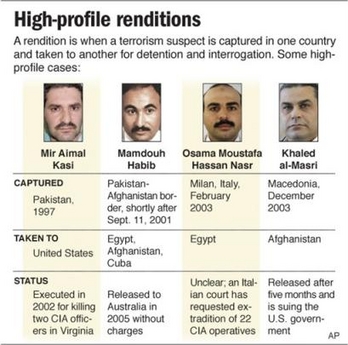|
CIA probes renditions of terror suspects
(AP)
Updated: 2005-12-28 10:28
The CIA's independent watchdog is investigating fewer than 10 cases where
terror suspects may have been mistakenly swept away to foreign countries by the
spy agency, a figure lower than published reports but enough to raise some
concerns.
After the terror attacks of Sept. 11, 2001, US President Bush gave the CIA
authority to conduct the now-controversial operations, called "renditions," and
permitted the agency to act without case-by-case approval from the White House
or other administration offices.
The highly classified practice involves grabbing terror suspects off the
street of one country and flying them to their home country or another where
they are wanted for a crime or questioning.
Some 100 to 150 people have been snatched up since 9/11. Government officials
say the action is reserved for those considered by the CIA to be the most
serious terror suspects.
Bush has said that these transfers to other countries �� with assurances the
terror suspects won't be tortured �� are a way to protect the United States and
its allies from attack. "That was the charge we have been given," he said in
March.

Chart shows examples of some high-profile
renditions.[AP] | But some operations are being
questioned.
The CIA's inspector general, John Helgerson, is looking into fewer than 10
cases of potentially "erroneous renditions," according to a current intelligence
official who spoke on condition of anonymity because the investigations are
classified. Others in the agency believe it to be much fewer, the official
added.
For instance, someone may be grabbed wrongly or, after further investigation,
may not be as directly linked to terrorism as initially believed.
Human rights groups consider the practice of rendition a run-around to avoid
the judicial processes that the United States has long championed. Experts with
those groups and congressional committees familiar with intelligence programs
say errors should be extremely rare because one vivid anecdote can do
significant damage.
Said Tom Malinowski, Washington office director of Human Rights Watch: "I am
glad the CIA is investigating the cases that they are aware of, but by
definition you are not going to be aware of all such cases, when you have a
process designed to avoid judicial safeguards."
He said there is no guarantee that Egypt, Uzbekistan or Syria will release
people handed over to them if they turn out to be innocent, and he distrusts
promises the U.S. receives that the individuals will not be tortured.
Bush and his aides have said the United States seeks those assurances �� and
follows up on them. "We do believe in protecting ourselves. We don't believe in
torture," he said.
In the last 18 months, his administration has come under fire for its
policies and regulations governing detentions and interrogations in the war on
terror. At facilities run by the CIA and the U.S. military, graphic images of
abuse and at least 26 deaths investigated as criminal homicides have raised
questions about how authorities handle foreign fighters and terror suspects in
U.S. custody.
Senior administration officials have tried to stress that the cases are
isolated instances among the more than 80,000 detainees held since 9/11. Yet
much remains unknown about the CIA's highly classified detention and
interrogation practices, particularly when it grabs foreigners and spirits them
away to other countries.
With the help of the American Civil Liberties Union, Khaled al-Masri, a
German citizen of Lebanese descent, has sued the CIA for arbitrarily detaining
him and other alleged violations after he was captured in Macedonia in December
2003 and taken to Afghanistan by a team of covert operatives in an apparent case
of mistaken identity.
Speaking to reporters by video hookup from Germany this month, al-Masri said
he was "dragged off the plane and thrown into the trunk of a car" and beaten by
his captors in Afghanistan. Five months later, his complaint says, he was
dropped off on a hill in Albania.
Mamdouh Habib, an Egyptian-born Australian, was arrested near the
Pakistani-Afghan border shortly after 9/11 and flown to Cairo. He says for six
months he was tortured there and was later transported to Afghanistan and
Guantanamo Bay, Cuba. In 2005, he was released without charge and allowed to
return to Sydney.
Prior to 9/11, renditions were ordered to bring wanted criminals to justice.
But the purpose was broadened after the attacks to get terrorists off the
streets.
Renditions represent just a fraction of the captures handled by the CIA and
its allies. More than 3,000 foreigners have been detained in operations
involving the CIA and friendly intelligence services since 9/11, according to
the intelligence official. Sometimes the United States may merely be providing
information, training or equipment for the operations.
Countries including Jordan and Egypt are believed to cooperate with the
operations. Although Saudi Arabia is thought to be involved, its ambassador to
the United States has denied accepting any cases at the United States' request.
The spotlight on the issue has called attention to how the CIA does its work,
causing consternation among some agency officials who prefer to operate in the
shadows.
For instance, planes operated by CIA front companies are often used to move
the terror suspects from one country to another, bringing scrutiny to a secret
agency fleet that's traveled in the United States, Spain, Germany, Afghanistan,
Poland, Romania and elsewhere.
Intelligence officials said the planes are more likely to be carrying staff,
supplies or Director Porter Goss on his way to a foreign
visit.
|